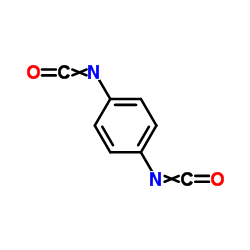1,4-Diisocyanatobenzene

1,4-Diisocyanatobenzene structure
|
Common Name | 1,4-Diisocyanatobenzene | ||
|---|---|---|---|---|
| CAS Number | 104-49-4 | Molecular Weight | 160.130 | |
| Density | 1.2±0.1 g/cm3 | Boiling Point | 236.2±23.0 °C at 760 mmHg | |
| Molecular Formula | C8H4N2O2 | Melting Point | 96-99 °C(lit.) | |
| MSDS | Chinese USA | Flash Point | 92.4±28.0 °C | |
| Symbol |



GHS05, GHS07, GHS08 |
Signal Word | Danger | |
|
Preparation of Pickering emulsions through interfacial adsorption by soft cyclodextrin nanogels.
Beilstein J. Org. Chem. 11 , 2355-64, (2016) Emulsions stabilized by colloidal particles are known as Pickering emulsions. To date, soft microgel particles as well as inorganic and organic particles have been utilized as Pickering emulsifiers. Although cyclodextrin (CD) works as an attractive emulsion s... |
|
|
Enzyme immobilization on silane-modified surface through short linkers: fate of interfacial phases and impact on catalytic activity.
Langmuir 30(14) , 4066-77, (2014) We investigated the mechanism of enzyme immobilization on silanized surfaces through coupling agents (cross-linkers) in order to understand the role of these molecules on interfacial processes and their effect on catalytic activity. To this end, we used a mod... |
|
|
Molecular layer deposition of functional thin films for advanced lithographic patterning.
ACS Appl. Mater. Interfaces 3(2) , 505-11, (2011) Photoresist materials comprise one of the main challenges faced by lithography to meet the requirements of electronic device size scaling. Here we report for the first time the use of molecular layer deposition (MLD) to produce photoresist materials with cont... |
|
|
A quinoline based bis-urea receptor for anions: a selective receptor for hydrogen sulfate.
Nat. Prod. Commun. 7(3) , 301-4, (2012) A dipodal bis-urea receptor has been synthesized from the reaction of 8-amino quinoline and 1,4-phenylene diisocyanate in dichloromethane, and the anion binding ability of the receptor has been studied using fluoride, chloride, bromide, iodide, perchlorate, n... |